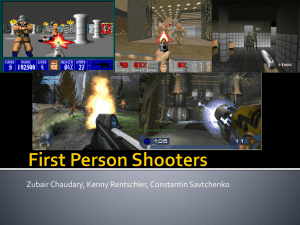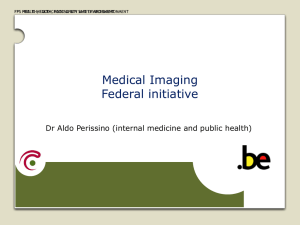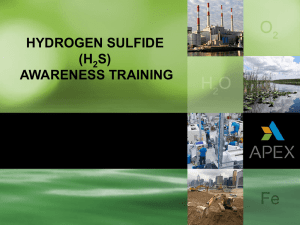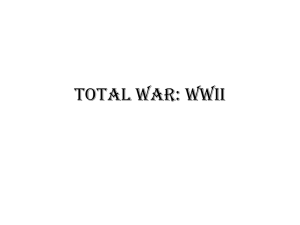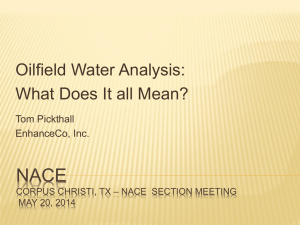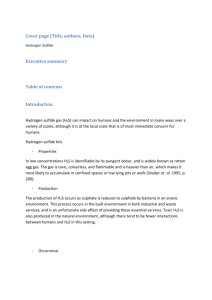First Person Shooters - Computer Science & Engineering
advertisement
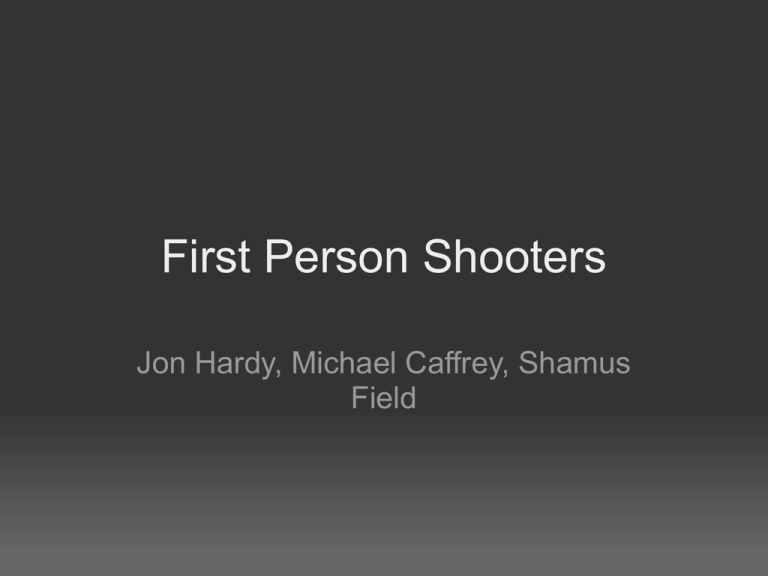
First Person Shooters Jon Hardy, Michael Caffrey, Shamus Field History of FPS http://en.wikipedia.org/wiki/Firstperson_shooter#History Origins of FPS Games • First game to be available to consumers was Battlezone, a tank simulator • Battlezone was originally released for arcade platforms, then later became available for personal computers in 1983 • Battlezone Gameplay Footage Late 80's - Early 90's • This was a transitional period that would lead to ideas which would be part of FPS games to come • One of the biggest developments of this period was Ultima Underworld by Looking Glass Technologies • Ultima Underworld introduced texture mapping to allow for faster gameplay, as well as visible hands and weapons of the player Catacomb 3-D Mid 90's • This is the period when FPS games saw a marked rise in popularity • Games released include Wolfenstein 3D, Doom, Marathon, and Duke Nukem 3D • Wolfenstein 3D is often credited with the invention of the true first person shooter • Wolfenstein 3D Gameplay Footage Late 90's • The late 90's mostly saw an increase in the graphics capabilities of FPS games and an increase in multiplayer settings • One of the most important releases of this time period was Quake, the first FPS to have online multiplayer resembling the games of today • GoldenEye 007 was the first bestselling console shooter • Valve released Half-Life, one of the first FPS games praised for its AI capabilities, and later Counter-Strike, a multiplayer game based on the Half-Life engine Early 2000's • The early 2000's saw a proliferation of FPS games and created a boom in the FPS market, making it one of the best selling genres • Games released include the start of many ongoing series such as Halo, Battlefield 1942, Call of Duty, and Resident Evil Modern Day • Modern FPS games have incredible graphics, smooth gameplay, and strong AI characters • Popular games include Halo 3, Battlefield 3, and the ongoing installations of Call of Duty • Battlefield 3 Gameplay Footage vs. FPS AI Architecture AI Game Programming Wisdom #2 Chapter 8.1 FPS AI Architecture • Divided into four major components: animation, movement, combat, and behavior • Animation: responsible for controlling the character's body • Movement: responsible for figuring out how the character should move, pathfinding • Combat: responsible for assessing the character's tactical situation, selecting tactics, aiming and firing, picking up weapons, etc. This component is usually most important in the player's perception of the AI • Behavior: responsible for communicating to the other components what the character's goal is and what those components should do The Animation Controller • Responsible for the character's body • Generally plays pregenerated animation sequences which take control of the character's entire body (ie. a death animation) • Must also be aware of which animations move which parts of the body and resolve conflicts when multiple animations are played (if a character is shot while doing an arm-wave animation sequence, the death animation should override it) • Also controls parametrization of existing animations (change the speed of a walk), controlling specific body parts (point down a hallway), and handling inverse kinematics (reach and grab a gun on a table) Pathfinding in FPS • FPS game worlds are often mostly static, so databases are pregenerated for fast pathfinding (similar to transition tables) • A* is commonly used with these databases to find the optimal path from point to point • Dynamic obstacles are dealt with by local pathfinding, built on top of global pathfinding. Local pathfinding is often done by sampling a grid oriented toward the destination and finding a way around objects The Movement Controller • Subsystem which performs tasks given by other components, usually in the form of "move to point (x, y, z)," or "move to object O," or "stop moving" • Handles only one movement command at any time • Takes commands and uses pathfinding to make the game engine calls to execute that path • Handles different types of movement such as walking, swimming, and flying The Combat Controller • Handles all combat related tasks such as picking a target, selecting a weapon, maneuvering, and firing weapons • This component poses very difficult problems such as what tactics to employ, as well as how to use spatial reasoning • Battlefield 3 AI Spatial Reasoning • Using the raw geometry of a level is not viable due to the sheer amount of polygons and irrelevant details • As with global pathfinding, a database is created for the tactics for a level based on cover, choke points, and vulnerable areas • Just as dynamic obstacles pose a problem for global pathfinding, dynamic environments can make these spatial tactical databases work poorly (what if a player pushes a block into a room to use as cover?) Combat Tactics • AI has a library of tactics it can draw from • These tactics communicate with the movement and animation components to ensure behavior is executed correctly • Some AI tactics included in many FPS games are: o Camp o Joust (run past opponent while shooting, then shoot from behind) o Circle strafing o Ambush (hide behind cover, pop out to shoot) o Flee and ambush (run away, then prepare for an opponent who may be chasing) Tactic and Opponent Selection • Tactic Selection o Based on three main factors: nature of the tactic, tactical significance of combatants' locations (based upon the spatial tactics database), and tactical situation (health, ammo, location, etc.) • Opponent Selection o AI will focus on one enemy at a time o Generally worry about defending self first, then, if it is safe, find a vulnerable target nearby with a ranking system o Remember Robocode? Many teams used some form of opponent selection Behavior Controller • Overarching controller responsible for determining state and high-level goals • Usually modeled with a finite-state machine • Some AI behaviors included in many FPS games are: o Idle o Patrolling o Combat o Fleeing o Searching o Summoning assistance • These behaviors are used to tell the other components of the system what to do Scripts and Triggers • Designers often like the AI to react in a certain way to scripted events in the game • The most common way of dealing with this is to send commands to the different components when the event happens • Call of Duty 4 Mile High Club Stealth Games and Perception • Some games have stealth systems where players must avoid the AI guards; these games often use alert levels for the AI based on their perceptions • These perceptions are modeled with visual, auditory, and tactile subsystems • Visual deals with distance, field of view, and line of sight • Auditory deals with ensuring the AI receives sounds from the game engine along with data such as where the sound came from and what other noise is occluding the sound • Tactile deals with what the AI feels, such as being shot or damaged, or collisions Ranged Combat and Spatial Analysis Ranged Weapons • Bows and Arrows, Rifles and Cannons • All travel over time, ideally hit opponent http://etc.usf.edu/clipart/5900/5994/archery_3.htm Imperfect AI • AI needs to miss - it's not fun for the AI to be "perfect" • How can we make AI "appear" proficient but be "bad" Basis - Other Games • Tabletop games have resolved ranged combat for decades o Dungeons and Dragons o Warhammer 40k o Necessarily simplistic o Can still model combat http://www.de-witteridder.be/uploads/3/3/4/2/3342427/warhammer_40000_5th_edition_reference_sheet.pdf Factors • Start with probability 1 • Multiply it by each factor: o AI Skill o Range o Size of Enemy o Enemy's Velocity o Line of sight o Enemy State • This creates a chance to hit Turn Chance to Hit into hits and misses • On Hit o Pick a point in enemy's hit box o Draw vector to that point If vector collides, go back to line 1 o Otherwise, position gun to that point and fire • On Miss o Pick a point reasonably close to enemy o Draw vector to that point If vector collides at a distance less than d, go back to line 1 Otherwise, position gun to that point and fire Oops, he's on my team! • If test vectors collide with teammate o Try different vectors o Move location Bounding Spheres • Area of effect weapons, like Grenades • Give Grenade object an exaggerated size o roughly as big as impact • Can also account for movement of teammates Bows and Arrows? • For some projectiles, travel time matters (RoboCode) o Enemy 200 meters away, arrow moves at 50 meters/second o 4 second delay, opponent can move way past target o Dead Reckoning; assume opponent continues moving at same pace and shoot there Spatial Analysis • Combat is confusing • Many different activities occurring simultaneously o Efficient system to analyze all of them at once Spatial Database • multiple 2-D matricies o openness - proximity to obstacles o cover - locations to take cover from obstacles o searching - find enemies o occupancy - distribution of allies o line-of-fire - direction of allies o light level - brightness of map sections • Layers combine to form views of world Openness Layer • How much room do I have to maneuver? • Gradient Matrix describes room, direction of walls and middle Area Occupancy • Calculate Density of enemies • Represent density of enemies o navigate / shoot around it Area Search • Goal: Find all hidden enemies in the area • Process o Identify areas where no friendly unit has been, mark them "unknown" o Move to closest "unknown" territory Line of Fire • Push barrier forward from muzzle of gun • Mark those areas as "dangerous" • Don't move into other units line of fire And in 3-D? • Layer more, smaller maps • For most cases, function is identical • Most aspects can be computed in advance Dynamic Tactical Position Evaluation Why not use static positions? • Positions and battles are repetitive • Levels require excessive coding • Games are becoming more complex, and static positions are difficult to implement in a wide variety of situations • Impossible to foresee all player actions • Interactions between AI, player, and game is difficult to manage Dynamic Position Overview • Use basic static procedures supplemented with information received while the game is being played • Takes in many types of information to make a decision • Reduces scripting by giving a general action template • May not work in every case, but works in a vast majority • AI are more useful in different situations • Combines data from environment into single score level to judge positions • Different evaluations for different tasks (attacking vs retreating) • Can use several position evaluations for pathfinding Killzone Attack Example Goal: Select position to fire at attacker • Consider all positions within reasonable distance • Eliminate all taken positions and restricted positions • Generate scores for remaining positions: o Check proximity to threat o Evaluate line of fire to threat o Factor in cover from secondary threats o See if position is in preferred engagement range o Avoid friendly fire/threat's line of fire o Factor in nearby cover in case a new position is needed o Make sure no AOE attacks will be hitting the position • Verify highest score position is the best and move http://www.youtube.com/watch?v=o7pH3CvrDvw 4:32 Performance • Evaluation can be computationally expensive • Limit points looked at by: o Evaluate a small radius around AI o Restrict AI to some part of the map o Use pre-calculated LOS for threats o Limit evaluation factors • Estimated that within three seconds of travel time a new position will need to be evaluated • Area of operations can stop irrelevant AI's from consuming computer resources with checks AOE Attacks and Cover Fire • Specific type of position selections • AOE criteria: o No friendly fire, will not hit walls or obstructions o Threat in blast range o Determine arc with ray casts (expensive) • Cover Fire criteria: o Proximity to last known threat position o Nearby cover threat may flee to o Line of fire from AI to threat location Intelligent Scanning • Used to determine appearance locations of threats • Possible criteria: o Positions with non-visible neighboring locations o Partially visible locations o Locations with partial cover o Doorways, windows, and corners, where enemies are probable • Costly, must evaluate all positions in visible range, rather than within a certain distance • Possible to group positions in a general direction to reduce cost • Trade-off between checking all positions and looking unintelligent • Can predict possible re-appearance locations of a hiding threat Problems • Dynamic position selection and pathfinding are typically calculated as separate steps (good positions may be only accessible through tactically poor paths) • Poor evaluation algorithms may take lots of processing power or space, or may create poor AI decisions • Takes into account only the current situation, and does not take into account past or present situations (though some games may implement these features now) • Must place locations by hand, or create an automatic way of either generating them or making AI recognize them Finding Cover in Dynamic Environments Cover in Dynamic Environments • Games are becoming more complex every year • Poor AI can make the game too easy or ruin player's immersion • Many games have dynamic environments in both single and multi player modes (Red Faction: Guerrilla, Battlefield Bad Company 1 & 2, etc) • AI taking cover from player attacks is necessary for a successful FPS game • Scripting for taking cover is inadequate • Enemies taking cover makes a more realistic game Overview • Taking cover means "full cover", rather than half cover, or any other position where the AI could attack or be attacked • Generally: o Find all full cover locations o Check which offer full cover at current time o Move to best position • Uses ray casting to determine whether AI may be hit by a threat (ray from enemy gun to various AI body parts) • Multiple rays can reduce errors, such as an elbow or foot visible to a threat http://www.youtube.com/watch?v=8kf68dzjO24 1:00 Ray Casting Tests • Can have several degrees of testing for a blocked shot: o Ray hits any polygon o Ray hits something tagged as full cover (allows for some bullet penetration on some walls, and not on others in MW & Battlefield games) o Ray hits something with less force than would be required to go all the way through Level Annotation • Specify logical cover areas upon building level • Chosen cover is easily accessible to AI • Table contains all cover information and is available to AI as game runs • Problems: o Dynamic environments will ruin the information table, causing AI to behave poorly o Only "obvious" cover will be registered (a wall will be, where as a low terrain hill will not) o Cover must be designated as such by world builders Sensor Grid Algorithm • Ray casting done at runtime • Possible cover locations also generated at runtime o Lots of close cover, fewer farther locations • 7 main steps: o Find all threat locations o Choose sensor locations and densities o Find the ground level of the AI o Determine whether AI can stand on sensors o Check whether remaining sensors are out of sight of threats via LOS to AI body parts at various positions o Check whether object is useful and accessible o Move Using Both Methods • Pure sensor grid is too computationally demanding, especially for consoles with limited hardware • Some level annotation is done upon building the level, getting all cases of "obvious" cover • If an AI needs cover, it will search the table for a close position that was specified by the level creators • If no cover was found in a close proximity, it will run the sensor grid algorithm to determine cover • Much smarter than level annotation alone, while much faster than sensor grid alone • Little slowdown even on slower hardware Extensions • Ray tracings can be split between frames, rather than trying to search all at once • Sensors for the sensor grid algorithm may be done individually, going from closest to farthest, instead of all at once • Removing positions from the cover table when a piece of cover is destroyed • Combine close threat viewpoints to avoid doing separate calculations for each of them
